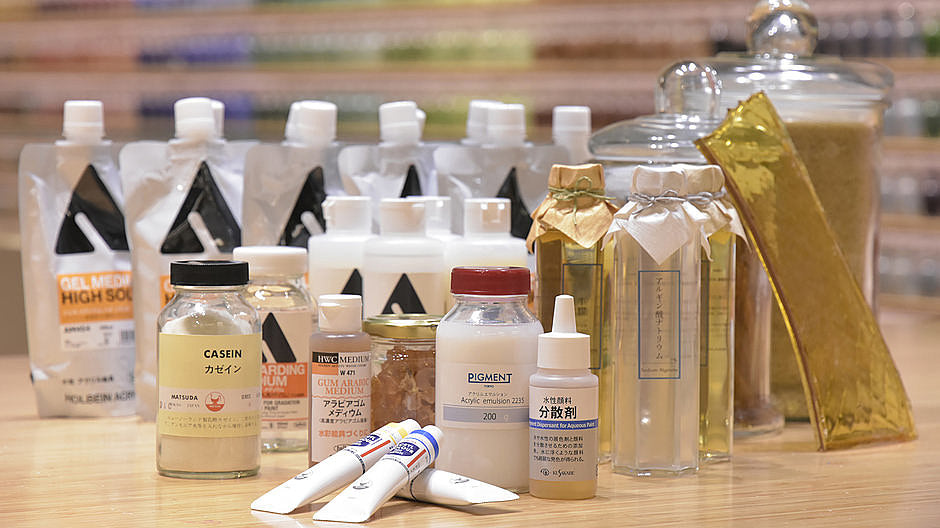What comes to your mind when you hear the word “medium”?
As is often featured in our website, there are various types of mediums, including water-based ones and oil-based ones. (Please take a look at “PIGMENT Chief Iwaizumi Talks About the Medium and Its Character vol.1” in PIGMENT ARTICLE as well.)
Let’s take water-based mediums, for example, there are different types of mediums.
How many of these are you familiar with?
1.Fresco(Fresco Paint)
2.Egg (Tempera Paint)
3.Casein medium(Casein Paint)
4.Animal Glue(Japanese Paint, Sumi-ink)
5.Gum Arabic(Watercolor, Gouache)
6.Acrylic Emulsion(Acrylic Paint)
7.Alkyd Emulsion(AQYLA)
You probably know the animal glue for Japanese paintings, watercolors, acrylic and AQYLA that you used in art class back in elementary school. However, some of you might not recognize the medium 1~3.
Today, from the viewpoint of “medium”, we would like to explore some of the collections from the Metropolitan Museum of Art. This museum has a free digital archive of the collection from across the globe. You can search for the collection from artist, title, country and era, etc.
The Metropolitan Museum of Art
https://www.metmuseum.org
The fresco painting is executed upon a wet, fresh plaster. Because the plaster itself becomes the medium holding the pigment, water is used to merge with the plaster. As the wall dries and sets, the pigment particles become bound, which gives the great permanence to the colors and resistance to aging.
One of the famous fresco paintings is a mural painting at Pompeii.

《Cubiculum (bedroom) from the Villa of P. Fannius Synistor at Boscoreale》(ca. 50–40 B.C.)
The Metropolitan Museum of Art
https://www.metmuseum.org/art/collection/search/247017
It is hard to believe that the work, which reminds us of Trompe-l'œil, was created before Christ. The fresco painting continued to grow after that, and flourished in Italy between the 14th and 16th century.
The next one is tempera paintings. Tempera paints are made by pigments and egg as medium, which gives the glossy surface and beautiful colors and is easier to paint with enough consistency.

《The Annunciation》(ca. 1485-92) Botticelli
The Metropolitan Museum of Art
https://www.metmuseum.org/art/collection/search/459016
In order to paint such details on a 19.1 x 31.4 cm sized canvas, the characteristics of these tempera paints must have been essential. The metal leaf was also used to express light. The tempera paint became considered as a traditional technique after the rise of oil paints in the 15th century, but it still has a lot of potential as a medium.
Lastly, we would like to introduce the casein medium, which is derived from milk by the action of acid. This has been used from pre-historic time, but there is an artist who applied casein to his modern artwork. That is Mark Rothko, an American painter known for his abstract paintings.

《Untitled》(1964)Mark Rothko
The Metropolitan Museum of Art
https://www.metmuseum.org/art/collection/search/486665
He used casein and acrylic for this work, but he also used tempera paints with combined techniques for the others. Bridget Riley, known as a pioneer of Op Art, is one of the artists who explored the expressions by mediums, and she also used casein and resins in her works.
The mediums mentioned in this article is just one of the examples; There are a lot of other mediums and each has different features and its use. Observing the characteristics and knowing them is very meaningful when you see the artworks, and when you create your own work as well.
Now, we are happy to announce that PIGMENT WORKSHOPS will have the first workshop of “The True Story of The Paints” series by Yoshiaki Aoki, the adviser of PIGMENT TOKYO and the professor of Kyoto University of Art and Design. This time, he will talk all about water-based mediums and resins from his unique viewpoint for both beginners and artists.

Workshop Information
[Special]The True Story of The Paints
Vol.1 Medium over Paints
Lecture by Yoshiaki Aoki
2019/06/16(Sun)
1pm – 4pm
*This workshop has ended.
You can register from the link below.
https://pigment.tokyo/workshop/detail?id=164&set_language=en
Reference
益田朋幸・幸多崎親・編著(2005),岩波西洋用語美術辞典,岩波書店(東京)

